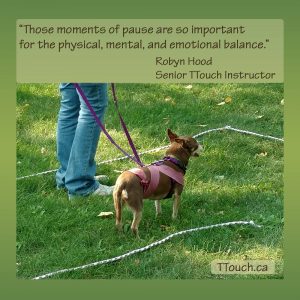 The Pause with a capital P is a simple but highly effective “tool” in all learning processes. When we pause, we give the animal the chance to process and assimilate the recent experience in order to learn from it. Sometimes we will find that after the pause a task which previously seemed impossible will simply flow because we gave the animal time to “regroup” rather than forging ahead at all costs. When we work respecting the pace of each individual we can go further more quickly. As Napoleon once said, “Dress me slowly because I am in a hurry”.
The Pause with a capital P is a simple but highly effective “tool” in all learning processes. When we pause, we give the animal the chance to process and assimilate the recent experience in order to learn from it. Sometimes we will find that after the pause a task which previously seemed impossible will simply flow because we gave the animal time to “regroup” rather than forging ahead at all costs. When we work respecting the pace of each individual we can go further more quickly. As Napoleon once said, “Dress me slowly because I am in a hurry”.
The following quotation from the “In Search of Memory” underlines the importance of the pause in Tellington TTouch work. The key lies in the periods required for a memory to transition from short-term memory to long-term memory. The author, Eric Kandel, who won the Nobel prize for medicine, explains an experiment carried out by the German psychologists Georg Müller and Alfons Pilzecker in 1900.
“Using Ebbinghaus techniques, they asked a group of volunteers to learn a list of nonsense words which they were asked to recall 24 hours later. They had no trouble doing this. Another group of volunteers was asked to learn the same list with the same number of repetitions, but they were also given another list of words which they had to memorise immediately after learning the first list. Twenty-four hours later the volunteers in the second group were unable to remember the words in the first list. A third group of volunteers who were asked to learn the second list two hours after learning the first one had no difficulty recalling the first list 24 hours later. This results showed that one hour after learning the first list, that information was still in the short-term memory and had perhaps begun the transition to long-term memory. The memory was still unstable. After two hours or more the memory had been consolidated and become stable which means that it would not be so easily forgotten.”
Another experiment was carried our in a school where one group of pupils went from one class to another without a break whereas a aecond group had a short break between each class. At the end of the day the recall of the second group who had had a break between classes was superior to that of the first group.
This information is important not only for TTouch work but also for any form of training, agility etc. as the pause gives the animal time to process the information received or the experience.
